![]()
![]()
As mentioned in Experiment 8-3, it has been long known that various substances distinctly color flames. In common temperature flames the energy excites the metals causing them to glow with distinct colors. In higher temperature flames, non-metals will also emit distinct colors.
Our eyes normally average together all the colors present in a flame or spark. This averaging often obscures any overlapping colors that are present. There are several ways to separate the different colors of light so each can be studied and recorded: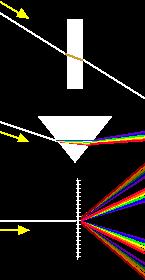
People have probably always noticed the colors of rainbows where light reflected inside nearly round raindrops is nearly all emitted at a surface not parallel to where it entered. But it was the English professor, Isaac Newton, who was the first to record experiments where he used two prisms, the first to separate sunlight into a rainbow of colors, and the second to reassemble it back to nearly white light. Newton noted that when he blocked some colors where separated between the prisms, the second prism did not produced not white sunlight, but some color. Newton concluded that all the colors of the rainbow were needed to make white light.
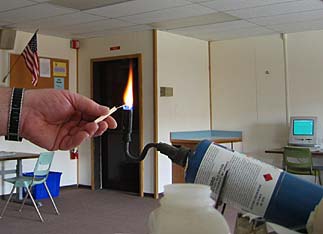 In this experiment analysis of colors, called spectral analysis, will be used to study light emited by chemical compounds heated by flames. In principle the colors observed in the spectra could be a combination of that of all elements present, due to just a portion of the elements in the compounds, or perhaps the colors are caused by interactions between elements so are different from that of isolated elements. This investigation should allow you to determine which of these is correct.
In this experiment analysis of colors, called spectral analysis, will be used to study light emited by chemical compounds heated by flames. In principle the colors observed in the spectra could be a combination of that of all elements present, due to just a portion of the elements in the compounds, or perhaps the colors are caused by interactions between elements so are different from that of isolated elements. This investigation should allow you to determine which of these is correct.
All experiments have some experimental error. In this experiment some errors are visible and therefore perhaps more apparent that in many other experiments. The accuracy of the colors you see on the computer monitor probably are not exactly the same colors you would see directly with your eye. And even your naked eye likely detects colors imperfectly. The difficulties might be compared to those encountered capturing an experience into language. In a language, espicially a primative one, there may be no words that accurately convey the complete experience. So some of the experience is lost in the translation to say ancient Greek. If the description is than translated to Latin, then to modern English, more accuracy may be lost. A rainbow of colors has an infinite variety of color like the infinite numbers along a segment of a number line. But the digital camera only has three detectors, each detecting the intensity of light over a limited range of color. Like describing the experience using the finite words of the Greek language, much of the description is lost in the capture into three color digital language. That digital information is accuately moved first from camera to one computer then over the internet to your computer and your monitor. But the translation by glowing phosphores in your monitor may be less than perfect just like translating from Greek to Latin. Finallly when you eyes with rods and cones transcribes the color combination into nerve signals for brain interpretation, it is like translating to modern English. Perhaps this analogy seems unnecessarily complex, but it is important to remember that while every step was as accurate as possible, the colors you see from the photographs below are probably not a perfect reproduction of the flame colors.
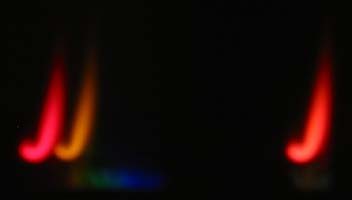 |
Lithium chloride, LiCl: Some of the light passed directly through the grating allowing a normalphotograph of the red flame on the far right. The grating spreads the colors forming spectra to both the right and left. But this photograph shows only the spectra to the left. Note that the light is actually two colors that are merged together in the normal view of the flame.
|
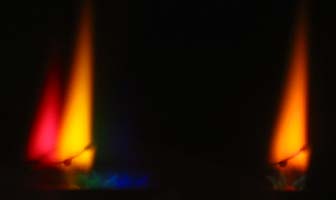 |
Strontium nitrate, Sr(NO3)2:
|
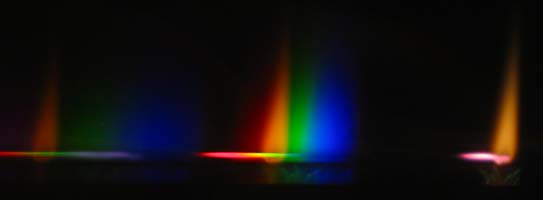 |
Cupper II chloride, CuCl2: This photograph not only includes the plain flame on the far right and the bright first spectral pattern in the middle, but it also shows on the far left a dimmer second spectral pattern wich is often visible. The supporting wire often glows white hot. This produce a complete spectrum of all rainbow colors seen roughly under the flame's spectrum.
|
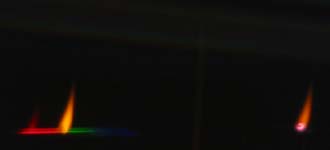
|
Strontium nitrate, Sr(NO3)2: another view from further away.
|
 |
Calcium chloride, CaCl2:
|
Do any of the different elements have identical spectra?
Record your results in your science journal. Write a Formal Report if you need to earn credit.